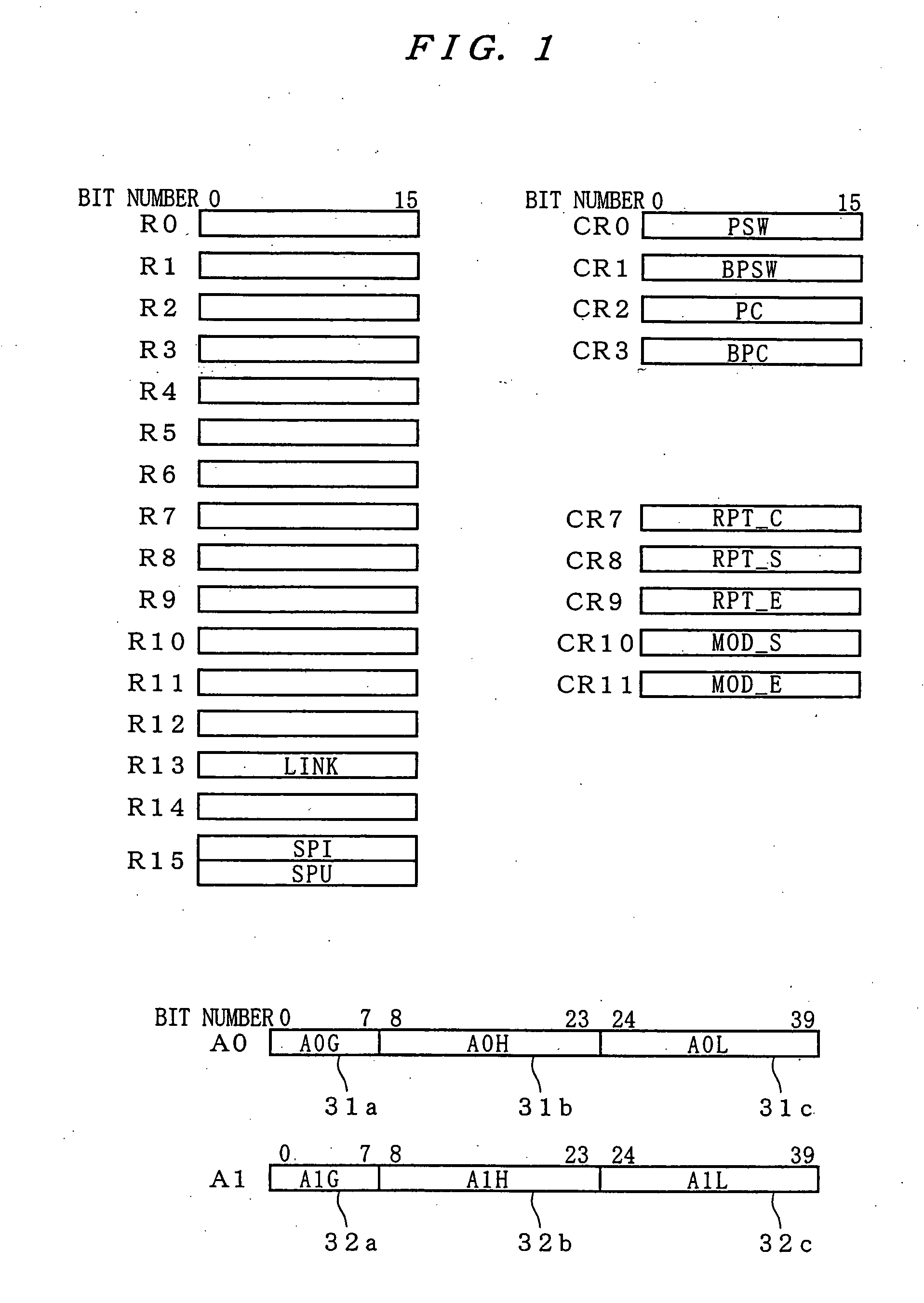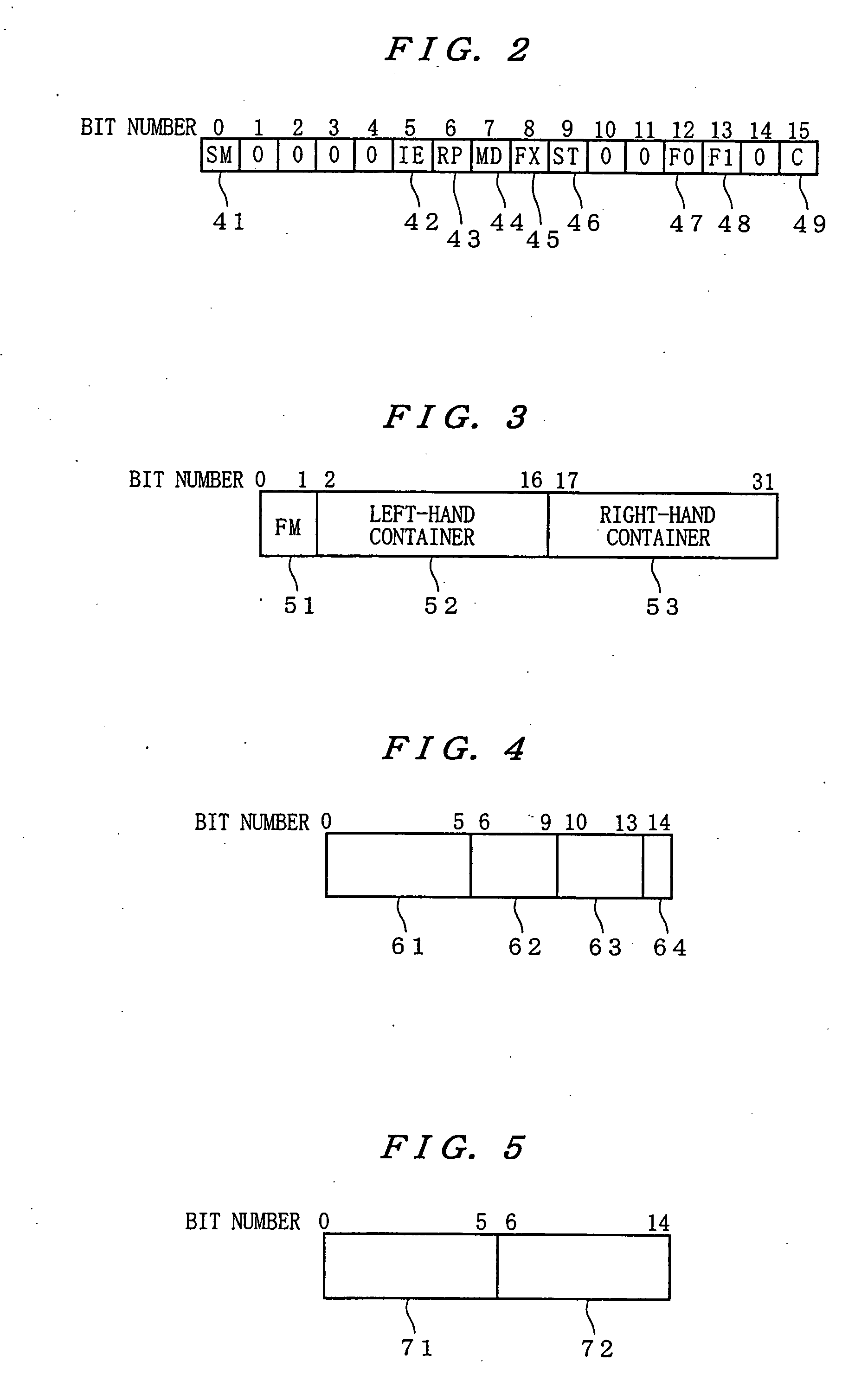Data processor
a data processor and high-performance technology, applied in the field of high-performance data processors, can solve the problems of overhead resulting from branch execution, code size enlarge, instruction lengthening, etc., and achieve the effect of reducing branch penalty and excellent code efficiency
- Summary
- Abstract
- Description
- Claims
- Application Information
AI Technical Summary
Benefits of technology
Problems solved by technology
Method used
Image
Examples
embodiment 1
[0115]
[0116] Now, a data processor of an embodiment 1 of the present invention will be discussed. The data processor of this embodiment is a 16-bit processor and processes addresses and data of 16 bits.
[0117]FIG. 1 illustrates a register set of the data processor of this embodiment. The data processor adopts Big Endian on the order of bit or byte, and the most significant bit (MSB) corresponds to the bit 0.
[0118] Sixteen general-purpose registers R0 to R15 each store data or address value. The registers R0 to R14 are general-purpose registers and the register R13 is designated as a LINK register to store a return address in execution of sub-routine jump instruction. The register R15 is a stack pointer SP, and a stack pointer SPI for interrupt and a stack pointer SPU for user which are switched over to each other by a processor status word PSW as discussed later. Hereafter, the stack pointers SPI and SPU are generally termed a stack pointer SP.
[0119] Except specific cases, 4-bit r...
embodiment 2
[0260] A data processor according to an embodiment 2 of the present invention is now described. The basic structure is identical to the data processor of the embodiment 1. In the data processor of the embodiment 2, a point comprising three flags which can be referred to as an execution condition is different from the data processor of the embodiment 1. Description is now made while noting the difference between the same and the embodiment 1 of the present invention.
[0261]FIG. 34 shows a processor status word (PSW) of the data processor of the embodiment 2. In the data processor of the embodiment 2, three flags of an F0 flag 47, an F1 flag 48 and an F2 flag 50 are updated in a comparison instruction or the like, and referred to as an execution condition. The point that the F2 flag 50 of bit 14 is added is different from the data processor of the embodiment 1, and allocation of the remaining bits is identical.
[0262]FIG. 35 shows instruction bit allocation of an execution condition s...
embodiment 3
[0270] While the case of unconditionally performing updating of three flags in comparison instruction processing has been shown in the embodiment 2, it may comprise two types of instructions of an instruction updating the flags other than the F0 flag 47 and an instruction not performing updating when updating the flags in the comparison instruction. As an example, FIG. 39 shows bit allocation of a comparison instruction of a short format. In a CMP instruction, it updates only the F0 flag 47 depending on an operation result, and in a CMPX instruction, it updates the F0, F1 and F2 flags 47, 48 and 50. The CMP instruction and the CMPX instruction are distinguished by “0” / “1” of an F field 752.
[0271] The basic structure is substantially identical to the data processor (FIG. 27, FIG. 38) of the embodiment 2. As elements, processing contents of a first decoder 112 (123), a second decoder 114 (124) and a flag update control unit 521 are different.
[0272] A flag update control unit (corres...
PUM
 Login to View More
Login to View More Abstract
Description
Claims
Application Information
 Login to View More
Login to View More - R&D
- Intellectual Property
- Life Sciences
- Materials
- Tech Scout
- Unparalleled Data Quality
- Higher Quality Content
- 60% Fewer Hallucinations
Browse by: Latest US Patents, China's latest patents, Technical Efficacy Thesaurus, Application Domain, Technology Topic, Popular Technical Reports.
© 2025 PatSnap. All rights reserved.Legal|Privacy policy|Modern Slavery Act Transparency Statement|Sitemap|About US| Contact US: help@patsnap.com



